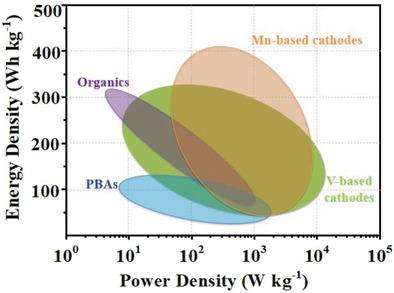当前位置:
X-MOL 学术
›
Adv. Mater. Interfaces
›
论文详情
Our official English website, www.x-mol.net, welcomes your
feedback! (Note: you will need to create a separate account there.)
Recent Advances and Prospects of Cathode Materials for Rechargeable Aqueous Zinc‐Ion Batteries
Advanced Materials Interfaces ( IF 4.3 ) Pub Date : 2019-07-03 , DOI: 10.1002/admi.201900387
Lineng Chen 1 , Qinyou An 1 , Liqiang Mai 1
Advanced Materials Interfaces ( IF 4.3 ) Pub Date : 2019-07-03 , DOI: 10.1002/admi.201900387
Lineng Chen 1 , Qinyou An 1 , Liqiang Mai 1
Affiliation

|
Electrochemical energy storage devices will definitely play a vital role in the future energy landscape of the world. The innovation of electrode materials is a key task for the breakthrough of present bottleneck faced by electrochemical energy storage devices. Aqueous zinc‐ion batteries (AZIBs) are gaining rapid attention, and they offer tremendous opportunities to explore the low‐cost, safe, and next‐generation green batteries for large‐scale stationary storage applications. In this review, the authors aim to give a comprehensive overview and summary of the recent progresses in cathode materials for AZIBs. Broadly, the authors classify the cathode materials for AZIBs into four groups: manganese‐based cathodes, vanadium‐based cathodes, Prussian blue analogs, and organic compounds. The reaction mechanisms, zinc storage properties, and several optimizing strategies of these cathode materials are summarized. Comparative observations of the main cathode families are discussed. Moreover, the emerging challenges and future research perspectives of cathode materials for AZIBs are proposed.
中文翻译:

充电式水性锌离子电池正极材料的最新进展与展望
电化学储能设备必将在世界未来的能源格局中发挥至关重要的作用。电极材料的创新是克服电化学储能装置当前瓶颈的关键任务。水性锌离子电池(AZIBs)受到了迅速的关注,它们为探索用于大型固定存储应用的低成本,安全和下一代绿色电池提供了巨大的机会。在这篇综述中,作者旨在对AZIBs阴极材料的最新进展进行全面的概述和总结。作者将AZIBs的阴极材料大致分为四类:锰基阴极,钒基阴极,普鲁士蓝类似物和有机化合物。反应机理,锌的储藏特性,总结了这些正极材料的几种优化策略。讨论了主要阴极系列的比较观察结果。此外,提出了用于AZIBs的正极材料的新兴挑战和未来的研究前景。
更新日期:2019-07-03
中文翻译:

充电式水性锌离子电池正极材料的最新进展与展望
电化学储能设备必将在世界未来的能源格局中发挥至关重要的作用。电极材料的创新是克服电化学储能装置当前瓶颈的关键任务。水性锌离子电池(AZIBs)受到了迅速的关注,它们为探索用于大型固定存储应用的低成本,安全和下一代绿色电池提供了巨大的机会。在这篇综述中,作者旨在对AZIBs阴极材料的最新进展进行全面的概述和总结。作者将AZIBs的阴极材料大致分为四类:锰基阴极,钒基阴极,普鲁士蓝类似物和有机化合物。反应机理,锌的储藏特性,总结了这些正极材料的几种优化策略。讨论了主要阴极系列的比较观察结果。此外,提出了用于AZIBs的正极材料的新兴挑战和未来的研究前景。

































 京公网安备 11010802027423号
京公网安备 11010802027423号